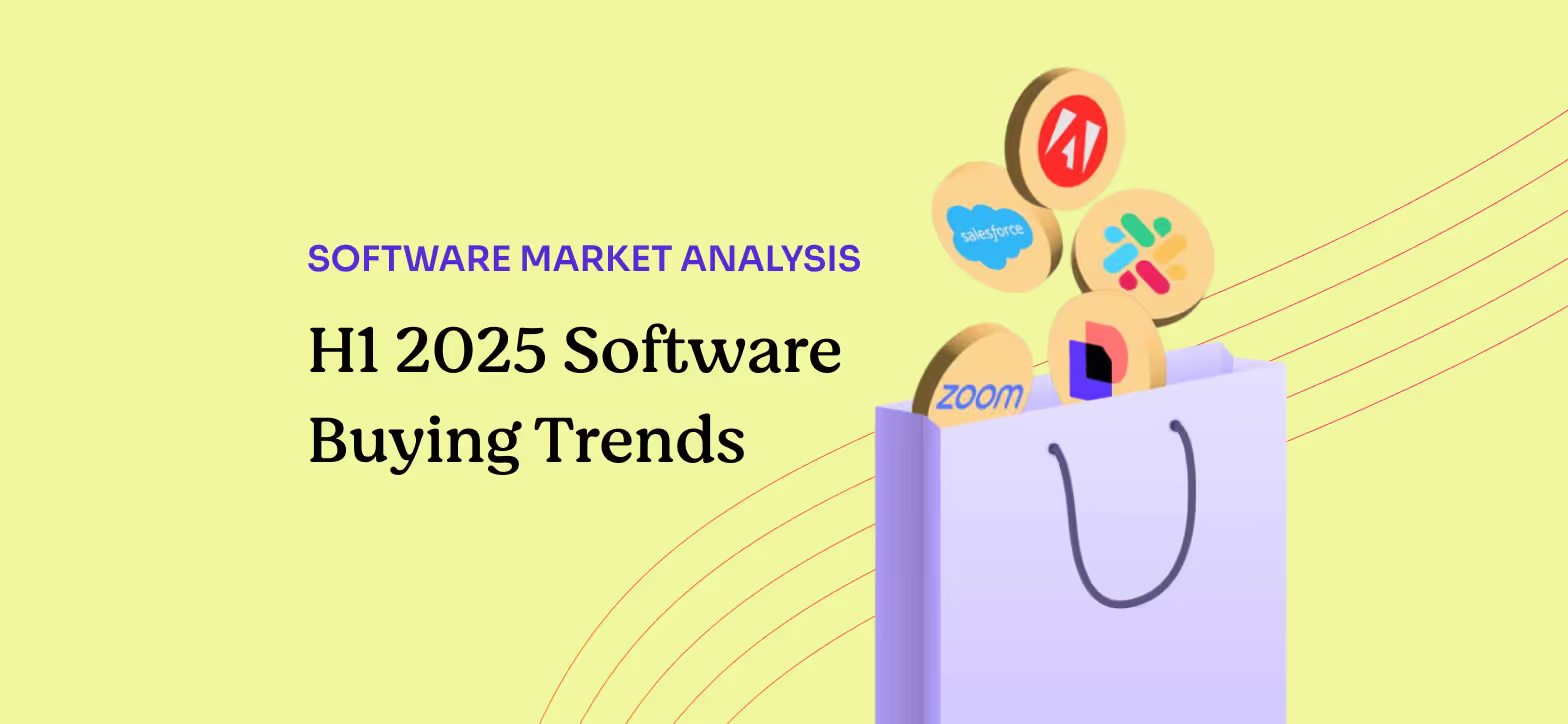Imagine walking into a dealership and every customer is paying a different price for the same car. Some are paying full sticker. Others, 30% off. A few, somehow, are driving away with half off and a free maintenance plan.
That’s what purchasing software looks like.
Businesses are closing deals they feel good about - strong discounts, firm handshake, clean approval. But zoom out, and that same contract might be 20%, 30%, even 50% more expensive than what a peer company is paying for the same license tier.
This isn’t about whether you're negotiating. It’s whether you know what’s actually possible.
Benchmark data from $15B+ in software spend reveals how much supplier pricing possibility can vary:
- DocuSign pricing ranges from -48.8% (25th percentile) to +62% (75% percentile).
- Figma? 0% price variability. Uniform pricing across the board.
- Suppliers like Atlassian, HubSpot, and Google Workspace offer double-digit negotiation room.
And yet, software continues to be one of the most persistent sources of cost expansion across businesses. Global investment reached nearly $675 billion by 2024, continuing to hold strong this year, and into 2026.
Meanwhile, procurement teams are feeling the pressure to extract more value out of this spend - and are optimistic about it. 48% of procurement professionals expected purchase cost-reduction savings to increase, while 55% think cost avoidance will also increase.
Put differently: software spend is massive, rising, and teams are expected to deliver more savings.
The Price Isn't Right
If you’re still treating all software suppliers the same when it comes to negotiation, you’re already losing ground.
Every supplier has a pricing DNA. Some are engineered for flexibility - sales-led organizations where individual reps have autonomy, regional offices create inconsistency, and margin expectations shift quarter to quarter. Others run tighter ships. Standard/strict pricing. Transparent packaging.
You’re not just asking “what’s the cost?” You’re asking “where’s the flex?”
That’s what price variability reveals. Here’s how our data stacks up for some of the top suppliers:

How You Should Be Interpreting Price Variability
Treat price variability like a spotlight. It shows you where you should spend time deploying your sharpest tactics and where to move on.
High price variability doesn’t necessarily mean chaos. Think of it as an opportunity. It means room to shape the deal. It’s often where a strong procurement strategy can drive real savings without burning bridges.
But don’t assume the inverse is negative. Low variability isn’t always bad news. It can reflect pricing discipline, product maturity, or go-to-market clarity. Most importantly, it saves you and your team time - the most undervalued currency in procurement.
The best teams are not solely just great negotiators. They’re great investors of time and effort. They know when to push, when to package, and when to walk.
And price variability data is a perfect compass to help you do just that.
- DocuSign is a perfect example. Most teams think they’ve already played their best hand. But a 111% pricing spread tells a different story: someone else is winning more. And that someone could be you, with the right data and negotiation levers.
- Similarly, Atlassian, HubSpot, and Google Workspace all present meaningful wiggle room - ranging from 13% to 27% on either side of the median. These are foundational tools that tend to spread widely across teams, which means even small percentage gains can have real dollar impact. If your team isn’t anchoring against the 25th percentile on these, you might be overspending at scale.
- Adobe’s ±8.6% variability puts them in a middle zone. There’s enough room to negotiate, but the window is tighter. In those cases, bundling or co-terming might be smarter levers than line-item price reductions.
- Zooming out, it’s worth asking: where is your team burning cycles for little upside? LinkedIn and Figma, with their tight bands of pricing, tell a different kind of story - one of internal consistency and low flexibility. Your time may be better spent finding savings elsewhere, or using those deals as models of pricing clarity.
And if variability looks flat, but your business needs have shifted dramatically, don’t rule out revisiting scope. Many companies overbuy seats or misalign tier levels with actual usage. A stagnant price doesn’t always mean a fair contract.
Finally, keep an eye on where pricing structures are evolving - usage-based pricing, AI seat costs, and modular packaging are complicating what used to be standard rate cards. Some variability is artificial, driven by opaque or experimental pricing schemes. The savviest teams are decoding these patterns and putting pressure on suppliers to simplify or clarify.
Variability Doesn't Stop At Price Either
Regardless of whether you're a finance leader or procurement head, it's our responsibility to be financial stewards of the business. And in volatile markets, capital allocation becomes the number one concern.
If you're deploying dollars without understanding what the rest of the market is paying, you're mostly always leaving money on the table and hurting margins (refer back to the chart above to see what I mean).
It's important to note that price variability doesn't stop at the sticker price of the contract. It creeps into payment terms, support levels, renewal clauses, ramp periods, and most critically - how much risk you’re baking into your plan without realizing it.
Here’s what I always ask my teams to surface:
- How standard are the commercial terms?
- Where are we above median on price and giving up flexibility?
- Is this contract structured to evolve with the business, or is it a ticking time bomb?
Smart procurement means zooming out to the full commercial envelope. For example, your pricing might be median, but you’re stuck with annual true-ups, poor prorating, or restrictive downgrade rights. With the emphasis on usage-based pricing today, flexibility is margin protection.
This is also where procurement can drive real partnership with finance - shaping contracts that match burn rates, growth curves, and real ramp scenarios. This flexibility is what protects the operating model when forecasts shift.
What Procurement & Finance Teams Should Do With This Data Right Now
- Prioritize Suppliers by Leverage Potential: Don’t treat every renewal equally. Create a negotiation roadmap based on high-variability vendors. You don’t need to play hardball with every supplier. Play hardball where it pays off.
- Use Data to Anchor Internally: When you ask for procurement air cover, bring benchmarks. Benchmarks turn gut feel into CFO-ready rationale. “We’re targeting a 30% improvement because the 25th percentile is 35% below our current rate.” Now you’re speaking my language.
- Watch the Clock: Start at least 90 days out. Earlier if it’s a critical or high spend vendor. Time is the invisible killer of negotiation power. Wait too long, and the renewal clock owns you. Start early, and you control the tempo.
- Automate the Feedback Loop: Use tools that surface price gaps automatically. Let the system tell you when you’re an outlier. No more digging through inboxes or spreadsheets to find last year’s rate card.
- Stop Chasing Dead Ends: Figma has 0% price variability. That tells you everything. Respect the model. Redirect your energy where you can make an impact
- Layer in Usage and ROI Analysis: Your best deal might still be a bad deal if adoption is weak. Build in metrics to validate whether you’re seeing value at renewal time. Otherwise, price becomes a distraction from actual performance.
- Document Learnings Across the Org: If you found major pricing variance in your CRM, don’t keep it siloed. Share it with the IT and Ops teams managing other categories. Build institutional muscle around spotting this early.
Let Data Direct Your Attention and Effort
What we don’t want is you running procurement cycles for the sake of it. You’re managing capital allocation in real-time. That means spend visibility is a prerequisite - you need to know what you're spending, how much you're spending, and why you're spending.
Procurement is often seen as a cost center. But with the right insights, it’s a strategic function that unlocks margin, resilience, and optionality. This isn’t just about shaving a few points off a renewal, but about building better spend discipline across your organization.
Price variability data tells you:
- Where to lean in
- Where to hold the line
- Where your capital is at risk of spoilage (operational waste)
So as you head into 2026:
- Use price variability to prioritize effort
- Use price benchmarks to anchor approvals
- Gain visibility to allocate capital responsibly
Related blogs
Discover why hundreds of companies choose Tropic to gain visibility and control of their spend.







.avif)